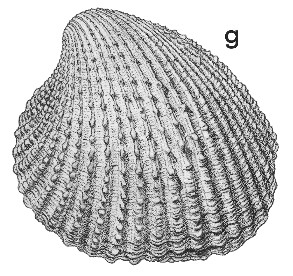
Revised descriptions of New Zealand Cenozoic Mollusca from Beu and Maxwell (1990)

 | Revised descriptions of New Zealand Cenozoic Mollusca from Beu and Maxwell (1990) | 
|
  (Pl. 23g): GS5095, D45/f8599, Slip Point, Clifden, Southland, Clifdenian (GNS) |
Beu & Maxwell (1990): Chapter 11; p. 218; pl. 23 g.
Synonymy: Venericardia subintermedia Suter 1917, p. 74; V. (Fasciculicardia) subintermedia; Cardita (Glans) kaiparaensis Marshall 1918, p. 272 (as Cardium (sic); see Laws 1944, p. 312)
Type species of Fasciculicardia Maxwell, 1969
Classification: Carditidae: Venericardiinae
Description: Rather large for family (length 50-70 mm), ovate-subquadrate to subrectangular, large shells more elongate than subadult shells, posterior margin slightly truncate, umbones very close to anterior end; posterior area weakly differentiated, slightly flattened or weakly concave. Lunule small, strongly pouting. Radial sculpture of 28-31 prominent, elevated costae with much broader interspaces, narrowly triangular in section proximally but becoming lower, broader and more rounded distally; most shells with 2 costae in middle of posterior area substantially less prominent than those on either side. Many costae flanked on posterior side, and in some shells on anterior side as well, by a much weaker ridge, producing characteristic fasciculate sculpture of genus. Crests of costae with prominent triangular tubercles or spines, or rounded nodules, which in most shells are not arranged in regular commarginal fashion; tubercles strongest anteriorly, over anterior part of flanks, and on posteriormost 2 or 3 costae, but weaker, even absent, elsewhere, and becoming obsolete distally on largest shells. Lower flanks of costae and intercostal spaces on well preserved shells with radial rows of minute papillae. Commarginal sculpture of growth wrinkles and ridges, most prominent distally, particularly near posterior margin. Hinge similar to that of G. (Fasciculicardia) acanthodes (Pl. 5g) but with left anterior cardinal tooth much closer to, and almost fused to, the lunular margin.
Comparison: Glyptoactis subintermedia is distinguished from other New Zealand species of Glyptoactis by its very large size, the number of radial costae (similar to that in G. benhami (Pl. 9c, d) but considerably greater than the 21-24 in G. acanthodes (Pl. 5g, h)), and the wide spacing of the costae. Judging by the distribution of this distinctive carditid (Northland, Westland and Southland) and its association at many localities with species of Septifer, Spondylus, Oniscidia, Conidae, etc., this was a warm-water species, possibly occupying the niche taken in the cooler east coast region by "Cyclocardia" awamoensis. The only record of Glyptoactis from the temperate province is from the Gee Greensand (Altonian) at Target Gully, stratigraphically below the famous shellbed. The specimen concerned differs from typical G. subintermedia in having more closely spaced and more densely nodulose radial costae, and probably represents a new species.
Distribution: Otaian-Lillburnian; Pakaurangi Formation, Pakaurangi Point, Kaipara Harbour, Otaian or Altonian (type locality of both V. subintermedia and C. (Glans) kaiparaensis); Coral Point, Kaipara Harbour; Stillwater Mudstone near Lake Ryan, near Greymouth; Clifden section from Calamity Point Sandstone to Lill Sand, locally common.
Cite this publication as: "A.G. Beu and J.I. Raine (2009). Revised
descriptions of New Zealand Cenozoic Mollusca from Beu and Maxwell (1990). GNS
Science miscellaneous series no. 27."
© GNS Science, 2009
ISBN
978-0-478-19705-1
ISSN 1177-2441
(Included with a PDF facsimile file
copy of New Zealand Geological Survey Paleontological Bulletin 58 in CD version
from: Publications Officer, GNS Science, P.O. Box 30368 Lower Hutt, New
Zealand)